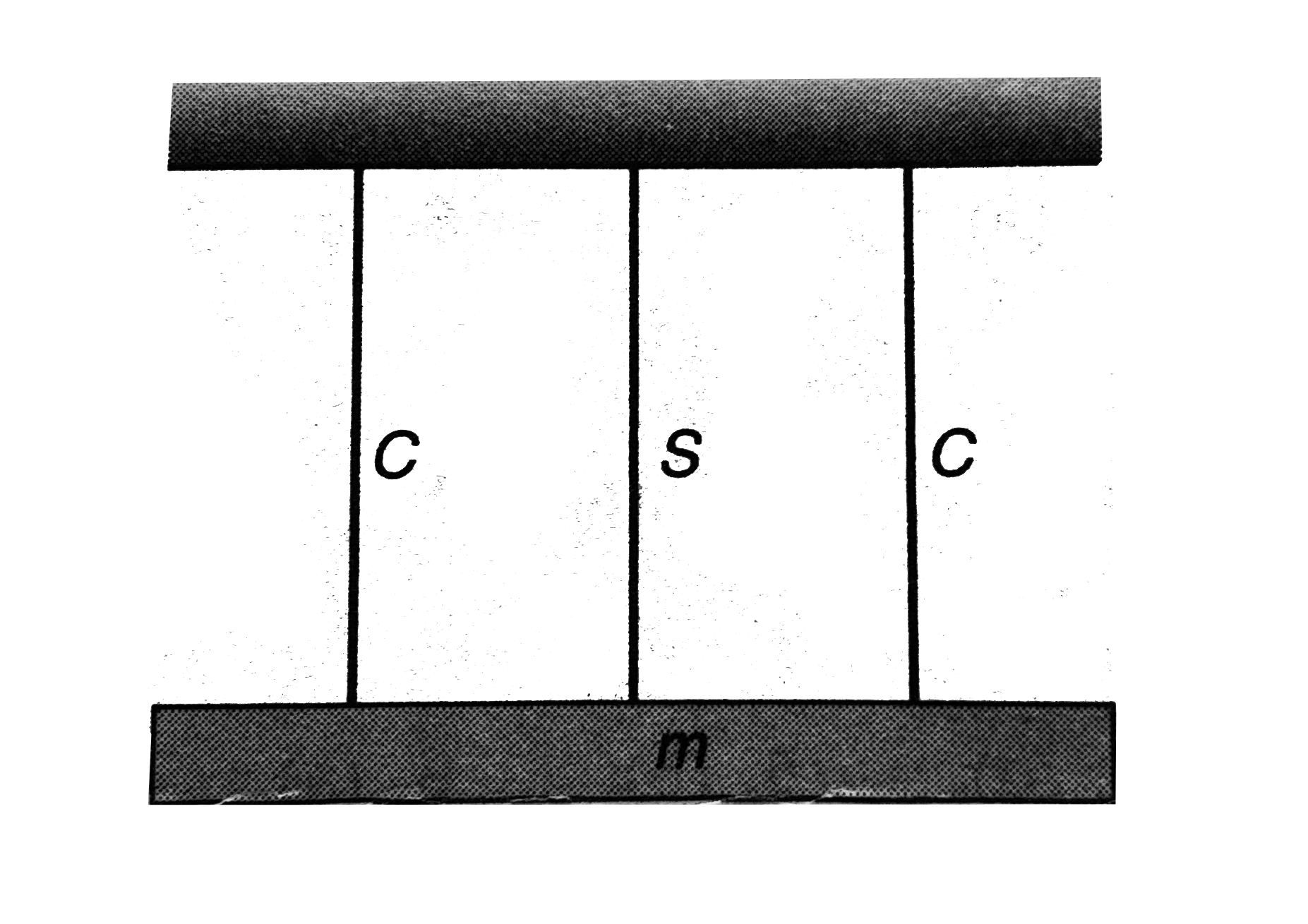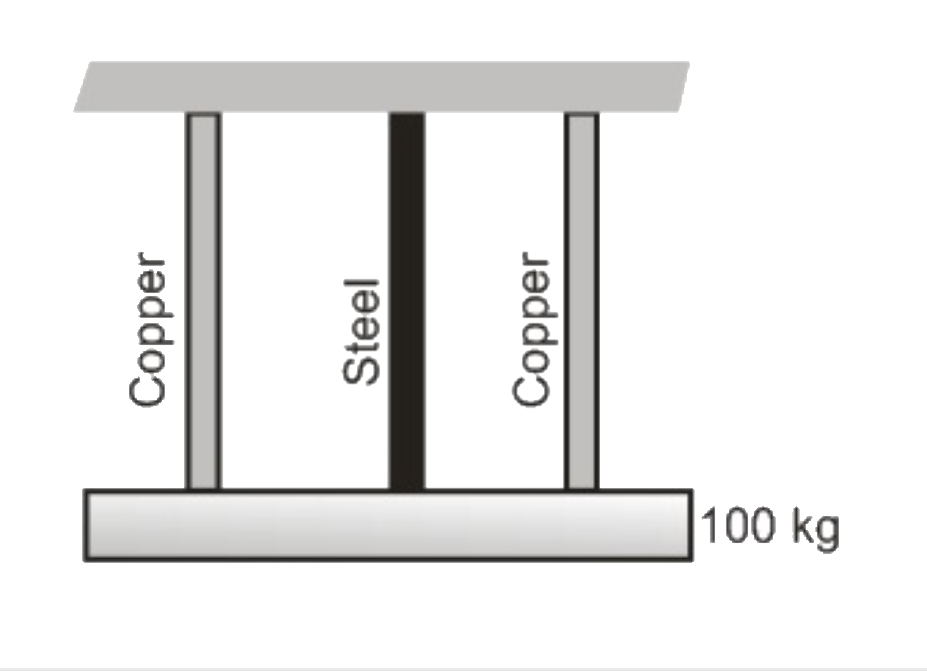A rigid bar of mass M is supported symmetrically by three wires each of length l. Those at each end are of copper and the middle one is of iron. The ratio of their diameters, if each is to have the same tension, is equal to
YcopperYiron
√YcopperYiron
Y2ironY2copper
YironYcopper
The correct Answer is:B
To solve the problem of finding the ratio of the diameters of the copper and iron wires, we can follow these steps:
Step 1: Understand the Setup
We have a rigid bar of mass M supported symmetrically by three wires: two copper wires at the ends and one iron wire in the middle. Each wire has the same length l and is subjected to the same tension T.
Step 2: Apply Hooke's Law
According to Hooke's Law, the stress in a wire is proportional to the strain experienced by the wire. The stress σ in a wire is given by:
σ=FA
where F is the force (tension) and A is the cross-sectional area of the wire.
Step 3: Relate Stress and Young's Modulus
The relationship between stress, strain, and Young's modulus Y is given by:
σ=Y⋅ϵ
where ϵ is the strain, defined as:
ϵ=ΔLL
where ΔL is the change in length and L is the original length of the wire.
Step 4: Set Up Equations for Each Wire
For the copper wire (with diameter dC):
TAC=YC⋅ΔLL
For the iron wire (with diameter dI):
TAI=YI⋅ΔLL
Step 5: Express Areas in Terms of Diameters
The cross-sectional area A of a wire can be expressed in terms of its diameter d:
A=πd24
Thus, we can write:
AC=πd2C4andAI=πd2I4
Step 6: Substitute Areas into the Stress Equations
Substituting the areas into the stress equations gives:
Tπd2C4=YC⋅ΔLL
Tπd2I4=YI⋅ΔLL
Step 7: Equate the Two Equations
Since the tension T and the strain ΔLL are the same for both wires, we can equate the two equations:
Tπd2C4=Tπd2I4
This simplifies to:
d2Id2C=YCYI
Step 8: Find the Ratio of Diameters
Taking the square root of both sides gives:
dIdC=√YCYI
Thus, the ratio of the diameters is:
dCdI=√YIYC
Conclusion
The correct answer for the ratio of the diameters of the copper and iron wires, if each is to have the same tension, is:
dCdI=√YIYC
We have a rigid bar of mass M supported symmetrically by three wires: two copper wires at the ends and one iron wire in the middle. Each wire has the same length l and is subjected to the same tension T.
According to Hooke's Law, the stress in a wire is proportional to the strain experienced by the wire. The stress σ in a wire is given by:
σ=FA
where F is the force (tension) and A is the cross-sectional area of the wire.
The relationship between stress, strain, and Young's modulus Y is given by:
σ=Y⋅ϵ
where ϵ is the strain, defined as:
ϵ=ΔLL
where ΔL is the change in length and L is the original length of the wire.
For the copper wire (with diameter dC):
TAC=YC⋅ΔLL
For the iron wire (with diameter dI):
TAI=YI⋅ΔLL
The cross-sectional area A of a wire can be expressed in terms of its diameter d:
A=πd24
Thus, we can write:
AC=πd2C4andAI=πd2I4
Substituting the areas into the stress equations gives:
Tπd2C4=YC⋅ΔLL
Tπd2I4=YI⋅ΔLL
Since the tension T and the strain ΔLL are the same for both wires, we can equate the two equations:
Tπd2C4=Tπd2I4
This simplifies to:
d2Id2C=YCYI
Taking the square root of both sides gives:
dIdC=√YCYI
Thus, the ratio of the diameters is:
dCdI=√YIYC
The correct answer for the ratio of the diameters of the copper and iron wires, if each is to have the same tension, is:
dCdI=√YIYC
Topper's Solved these Questions
- MECHANICAL PROPERTIES OF SOLIDSBOOK - NCERT FINGERTPS ENGLISHCHAPTER - MECHANICAL PROPERTIES OF SOLIDSEXERCISE - CORNER
15 Videos
- MECHANICAL PROPERTIES OF SOLIDSBOOK - NCERT FINGERTPS ENGLISHCHAPTER - MECHANICAL PROPERTIES OF SOLIDSEXERCISE - Hooke'S Law
3 Videos
- MECHANICAL PROPERTIES OF SOLIDSBOOK - NCERT FINGERTPS ENGLISHCHAPTER - MECHANICAL PROPERTIES OF SOLIDSEXERCISE - HOTS
8 Videos
- MECHANICAL PROPERTIES OF FLUIDSBOOK - NCERT FINGERTPS ENGLISHCHAPTER - MECHANICAL PROPERTIES OF FLUIDSEXERCISE - NCERT Exemplar
5 Videos
- MOTION IN A PLANE BOOK - NCERT FINGERTPS ENGLISHCHAPTER - MOTION IN A PLANE EXERCISE - Assertion And Reason
15 Videos
Similar Questions
A rigid bar of mass 15 kg is supported symmetrically by three wires each 2 m long. Those at each end are of copper and middle one is of iron. Determine the ratio of their diameters if each is to have the same tension. Young's modulus of elasticity for copper and steel are 110×109Nm−2 and 190×109Nm−2 respectively.
View SolutionA rigid bar of mass 15 kg is supported symmetrically by three wires, each of length 2 m. The wires at the endpoints are made of copper and the middle one is made of steel. If the tension in each wire is the same, then the diameter of copper wire to the diameter of steel wire is [Given, Ycopper=1.1×1011N m−1andYsteel=1.9×1011N m−2]
View SolutionTwo wires, one of copper and the other of iron, are of the same length and same radius. Which will have more resistance ? Give reason.
View SolutionTwo wires of equal length one of copper and other of manganin have the same resistance. Which wire is thicker?
View SolutionThree identical rods, each of mass m and length l, form an equaliteral triangle. Moment of inertia about one of the sides is

View SolutionA homogeneous block with a mass m hangs on three vertical wires of equal length arranged symmetrically . Find the tensions of the wires if the middle wire is of steel and the other two are of copper . All the wires have the same cross - section . Consider the modulus of elasticity of steel to be double than that of copper .

View SolutionA metal wire of length L is suspended vertically from a rigid support. When a bob of mass M is attached to the lower end of wire, the elongation of the wire is l:
View SolutionThree point charges, each with charge q and mass 'm', are connected by three strings of equal length l whose other end is connected to a fixed point P. They form an equilateral triangle of side 'a' in a horizontal plane. The tension in each string will be
View SolutionA heavy plank of mass 100 kg hangs on three vertical wires of equal length arranged symmetrically (see figure). All the wires have the same cross - section.
The middle wire is of steel and the other two are of copper . The modulus of elasticity of steel is assumed to be double that copper. Determine the tensions in the wire. (use g=9.8ms−2 )

View SolutionThree thin rods each of length Land mass M are placed along x, y and z-axes such that one end of each rod is at origin. The moment of inertia of this system about z-axis is
View Solution
